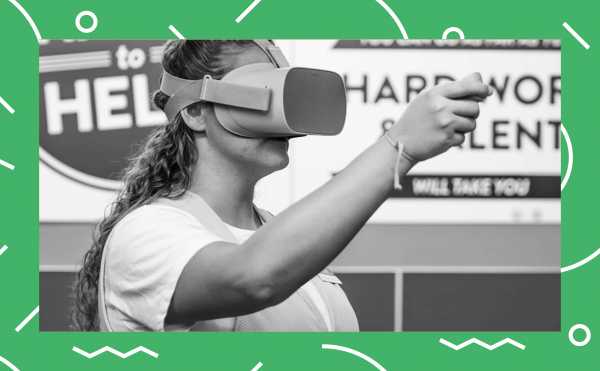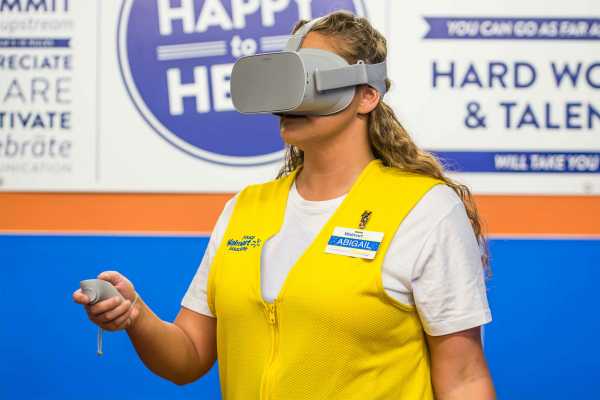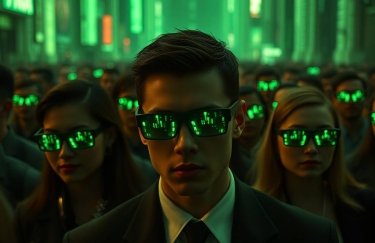
In Walmart’s virtual reality simulation, Black Friday never ends
Walmart’s technological embrace is a big bet on shopping’s human element.
By
Patrick Sisson
Nov 15, 2018, 7:00am EST
Share
Tweet
Share
Share
In Walmart’s virtual reality simulation, Black Friday never ends
tweet
share

Staring down a seemingly endless aisle of products, including an entire grocery store-within-a-store, it seems like the shopping never ends at Walmart’s Santa Clarita Supercenter, 30 miles north of downtown Los Angeles. Inside, through an entryway wedged between freezer cases full of seafood, past employee locker rooms, behind a door with a frosted glass logo — a Walmart icon superimposed on a graduate’s cap and tassel —one version of computerized commerce never stops.
This space attached to the retail floor is one of Walmart’s roughly 200 training academies, part of a two-year-old initiative to improve and expand training of the company’s roughly 1.2 million employee associates, the front-line workforce that meets, greets, and checks out customers. Contrary to many people’s perception of the low-cost leader, this training effort is very high-tech. Last year, the academies began offering lessons in virtual reality.
Designed by a Silicon Valley startup, these lessons showcase the value Walmart places in employee education, and the shifting fortunes of virtual reality. The largest corporate investment in the nascent VR industry, which will see 17,000 Oculus Go headsets sent to the company’s 4,700 US stores, offers a vision of the technological changes altering the retail landscape. It’s also an uncanny valley of grocery shopping.
Walmart’s virtual reality Black Friday simulation.
After slipping on an Oculus headset and tightening the velcro straps around my temple, I’m greeted by a boot screen, basically a white expanse in every direction, punctuated by black dots to form a grid. There’s a vibe of Neo and Morpheus in The Matrix, but instead of trading martial arts moves or leaping off buildings, I’m transported to the center of a busy intersection inside a Walmart store during Black Friday.
It’s a bit claustrophobic, with customers streaming past me in every direction. Spinning my head, I see a family pushing a cart filled with emoji slippers, then a man rushing past with a haul of electronics, and finally, a team of associates giving directions to lost shoppers.
As I circle around, the facilitator guiding me through the simulation can pause the action, allowing us to discuss, digest, and learn from what I’m seeing. I’m told the passing customers, who all seem to be casting glances at me, are doing so on purpose; the simulation is meant to put employees on the spot, letting them adjust to the pressure, noise, and expectations of Black Friday shoppers to gain situational awareness before the big day.
Retail’s survival of the fittest will be fought in stores, not just online
As the retail world continues to be rocked by changing consumer habits, Walmart’s massive bet on virtual reality may seem like a peculiar part of the company’s technology portfolio. After all, Walmart bought retail site Jet.com for $3.3 billion in a bid to bolster its e-commerce offerings and counter Amazon’s rise.
But the company’s VR play, and plans to bring virtual reality training to every associate, shows the world’s largest company is still investing in human resources and the in-store experience. Sometimes derided as a futuristic folly, or feared as another tech tool that will divorce us from reality, VR training, as Walmart executives and retail analysts see it, symbolizes the importance of the human element.
“The biggest advantage for us at Walmart is our associates,” says Brock McKeel, the company’s senior director of digital operations, and one of the executives who helped spearhead the VR push. “Anything we can do to make our associates better, and help them take care of their customers, is an advantage for us.”
“Almost everybody has good e-commerce. The store environment is where you can create differentiation.”
Brick-and-mortar retail isn’t going extinct. Amazon’s $13.7 billion purchase of Whole Foods last year was a move to gain a physical footprint in high-income neighborhoods across the country. But it will be survival of the fittest, determined in large part by technology.
“If you think about the overall marketplace today, pure-play e-commerce isn’t as competitive today as it was in the past,” says Robert Hetu, vice president and retail analyst at Gartner, a consumer research firm. “Almost everybody has good e-commerce. The store environment is where you can create differentiation. Walmart sees VR as a way to efficiently provide an elevated shopping experience.”
Walmart’s own research has found that VR learning improves employee retention of new information by 10 to 15 percent compared to the typical combination of videos, online demos, and classroom work. Scale that across thousands of stores, and those headsets suddenly seem like a shrewd investment. And as far as the VR industry sees it, Walmart’s huge purchase is a bellwether of how the technology will alter the corporate educational market. After capturing the low-hanging fruit of gaming, the technology is becoming more of an enterprise solution.
“When you consider their scale, it’s immeasurable,” says Andy Mathis, head of partnerships at Oculus for Business. “It’s that classic moment where a new technology has truly been discovered in a meaningful way. It’s a significant statement on not only the possibilities of VR in the future, but the possibilities right now. It’s ready today for impactful training for corporations, health care, and education.”
How a virtual Black Friday started on college football Saturday
Walmart’s path to virtual Black Friday simulations began in a locker room. At the company’s Bentonville, Arkansas, headquarters, home state pride for the University of Arkansas Razorbacks football team, which competes in the storied SEC and has a stadium in nearby Fayetteville, runs deep.
Like many college football teams, the Razorbacks have been investing in training facilities to give their players and team an edge. In 2015, the team became one of the first to buy into a new virtual reality training program for quarterbacks developed by a Silicon Valley startup named STRIVR (Sports Training in Virtual Reality). Derek Belch, formerly a coaching assistant at Stanford, came up with the technology. It uses 360-degree video to create simulated game scenarios, letting players hone their ability to make snap decisions in with less risk of injury.
Repetition without risk is the core value of VR training, according to Logan Mulvey, the company’s chief customer officer. STRIVR boils it down to the acronym RIDE: VR lets you train for rare, impossible, dangerous, or expensive scenarios, over and over again.
“Training a quarterback is the same as training a BMW employee on the factory floor. They both need to quickly assess their options and make a decision.”
“Training a quarterback is the same as training a BMW employee on the factory floor,” Mulvey says. “They both need to quickly assess their options and make a decision.”
Walmart’s McKeel, who was then building out the Training Academy program, had been looking at virtual reality as a potential training tool, but none of the the programs he’d come across struck him as particularly useful to Walmart. After hearing about STRIVR, he decided to investigate, and tested out the technology after a Razorbacks game in the fall of 2016.
“Seeing a scenario where quarterbacks can do repetitions in a safe environment to better prepare them for the game made a light bulb go off,” he says. “They were getting memorable experiences that prepared them for when things actually happened on the field. I thought this would be a great format for the Academies.”
The modules STRIVR designed for Walmart focus on in-store customer service. The produce simulation, for example, the first lesson ever built, presented managerial trainees with a disorganized “wet wall,” the row of fresh vegetables topped with misters and plastic bag dispensers.
During training in the academies, a two-week program for managers, one trainee goes through the simulation, tasked with identifying all 14 errors in 45 seconds. A facilitator asks questions and occasionally pauses the simulation, inviting the other trainees, who are watching the experience on a large screen in the classroom, to comment.
A Socratic method of sorts for shopping, this group learning experience allows for more interactive feedback and discussion. It also allows the company to standardize training across its expansive network of stores, and train large groups on picking up spills, or re-organizing the produce section, without having to shut down busy, revenue-generation parts of the store (20 to 30 percent of company sales comes from growing fresh food offerings). Mulvey said STRIVR has even created an active shooter drill for the company, giving employees guidance on how to handle such an unforeseen emergency.
McKeel says the VR training, done in four- or five-minute segments, cuts down training time, increases engagement, and improves employees test scores. It’s one thing to tell a new manager that Black Friday is insanely busy. It’s another thing to drop them in the middle of a packed store floor, or behind the counter at the electronics section as customers rush for discounted flat screens.
“We underestimated the classroom impact of VR,” says McKeel. “You don’t get this kind of engagement in normal, classroom-style learning.”
The program also allows employees to learn about, and even master, new services or technologies before they arrive at the store. Walmart has been rolling out the “16-foot-tall vending machines” they call pickup towers across the country, aiming to have them in 700 stores by the end of the year. With virtual reality, they can practice using the towers before they even arrive.
The coming age of retail augmentation
Walmart’s VR push represents how the traditional calculus around retail employees has changed, according to Gartner’s Hetu. It signals an age of retail augmentation, not retail obsolescence, as many have predicted. As more companies embrace unified commerce —tying together online and offline shopping to gain additional consumer insight and deliver a better experience — in-person customer service becomes more important.
“Five or six years ago, companies like Best Buy were seeing that customers came into stores with more knowledge than the associates,” Hetu says. “Now, they’ve turned things around, in part using technology to give employees more information. They’re investing in things that provide associates with more data and intelligence.”
Over the long run, Hetu predicts some retail staff will be eliminated, but mostly positions, like cashiers, that are easily mechanized and not focused on customer service. Corporations will focus on the critical human element in shopping, and invest heavily in tracking technology and robotics to help employees help customers — new technology, coincidentally, that can be learned in virtual reality simulations.
Dreama Lovett, 53, works in online grocery for a Walmart in Jacksonville, Florida, a service line targeted by the company’s virtual reality training initiative. While Lovett has yet to try out the Oculus headset, she says technology, such as the new pickup tower her store will receive in January, is becoming a bigger and bigger part of the job.

“What I do for a living with Walmart is going to be the new way of life,” she says. “All stores are going to be focused on online pickup and delivery. It’s the new way, part of the evolution and transition of the company.”
Walmart itself is investing in other technology to make associates more efficient, including a robot assistant from Bossa Nova Robotics that scans stores looking for out-of-stock items and shortages and alerts associates, as well as a mobile scheduling app to make staffing more efficient.
All this technology is an investment in improving service, and eliminating bumps in performance as new employees get up to speed, or when retail brings on huge numbers of temporary employees during the seasonal rush. Now that Walmart has “kicked the tires” and shown the works, says Ramon Llamas, a tech and VR analyst for IDC, he predicts companies such as Home Depot and Lowe’s will see VR training as a best practice.
While more, better, and faster retail workers would please any large corporation, in a tight labor market with low unemployment — The Wall Street Journal predicts a shortage of seasonal employees this year — new technology can also be seen as a recruiting tool.
Babs Ryan, a vice president and consulting director at Forrester Research covering consumer and retail, says retail faces a labor crisis. Beyond seasonal shortages, it’s harder and harder to find and retain good talent. Technology can help keep talent engaged and excited.
“It’s not about employees earning another dollar an hour,” Ryan says. “It’s making you want to wake up and do your job every day. The big thing is human interaction, or lack thereof. It’s about better on-boarding, a better experience, and using technology to bring in the human element.”
“These virtual assistants seem way out there, but think about the important aspect that ties them together. Employees don’t feel alone.”
Ryan views the shift toward retail augmentation less about relentless efficiency, and more about relieving employees of boring, burdensome, rote work while giving them the tools and confidence to have better interactions with customers. Ryan believes this retail tech push will eventually aim to turn more and more employees into style guides and curators.
She points to companies like Stitch Fix, the online clothing subscription service, as a model; customer data and tech provide employees with the information to make recommendations and relate to customers. Walmart, in fact, has been working on its own variation of the concept, launching a personal shopping service called Jetblack.
“These virtual assistants seem way out there, but think about the important aspect that ties them together,” she says. “Employees don’t feel alone. Someone has my back, and someone is there when I need them.”
A new way to learn from employees
Walmart is far from alone when it comes to investing in virtual reality. Farmers Insurance has used VR for corporate training, helping adjustors learn how to evaluate accidents. STRIVR also lists Chipotle and Lowe’s as clients.
Tech firms hope more corporations embrace the technology as it evolves. According to Mulvey, STRIVR customers now have more data about their employee behavior than ever before. By training staff in an immersive environment, companies can track every single movement and use this information to study efficiency, improve processes, and even alter the layout of stores and facilities.
Companies will also be more nimble; new processes and technology can be rolled out faster and faster, with employee feedback and iterative improvement available before customers see a single change on a store floor.
“This technology gives you total certainty of what employees are doing,” says Mulvey. “We’ve given companies the ability to take a deeper look at the way that their employees behave.”
While the idea of tracking movements can invoke Big Brother comparisons, it can also make work safer. IDC’s Llamas foresees a future where workers train on virtual forklifts, taking the multi-million dollar pieces of machinery for a spin in VR, with no risk of injury or accidents. Costly mistakes, for both the company and workers, can be avoided.
As training modules evolve to tackle even more complex interactions and experiences, VR may become a means to improve soft skills and build confidence. STRIVR sees a future with more crisp visuals, and branching technology, a choose-your-own-adventure update which will allow virtual customers or employees in these simulations to not only interact more, but change their responses, and the module’s storyline, based on how the learner interacts.
According to Oculus’s Mathis, the company’s forthcoming Quest headset, set to launch in the first half of 2019, is their first all-in-one VR system that will track hands and allow free movement, and improve engagement and interaction.
“You don’t realize your mannerisms, that you’re slouching in the chair, that you don’t make eye contact, and all these little things mean a lot.”
“It opens the floodgates for highly technical and advanced programs,” he says.
These advances will continue to change how employees learn. It’s a phenomenon that Walmart’s McKeel has already observed. During some of the classroom feedback at Walmart training academies, learners are shown videos of how they’re performing, in effect, judging themselves.
“You don’t realize your mannerisms, that you’re slouching in the chair, that you don’t make eye contact, and all these little things mean a lot,” he says.
In an interactive world, you can, in the language of an athlete, get the reps, and make learning more interactive. Virtual reality’s growing role in education shows a truism of technology’s evolution. It’s can be more fantastical, all-encompassing, and ultimately, prosaic, than science fiction might imagine.
Want more stories from The Goods by Vox? Sign up for our newsletter here.
Sourse: vox.com






